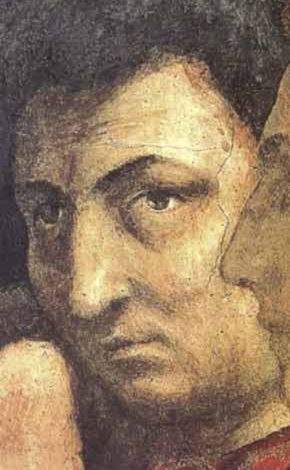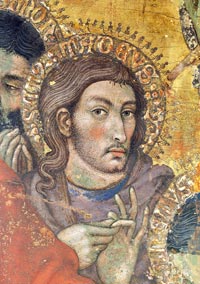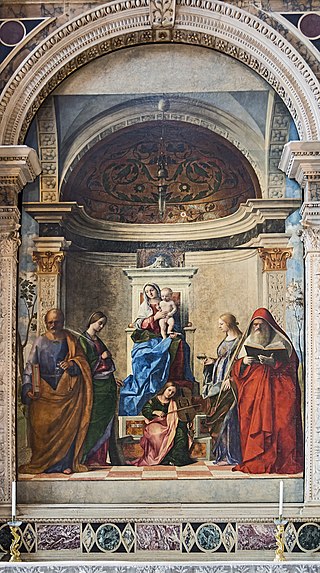
Fra Angelico, OP was a Dominican friar and Italian painter of the Early Renaissance, described by Giorgio Vasari in his Lives of the Artists as having "a rare and perfect talent". He earned his reputation primarily for the series of frescoes he made for his own friary, San Marco, in Florence, then worked in Rome and other cities. All his known work is of religious subjects.

Masaccio, born Tommaso di Ser Giovanni di Simone, was a Florentine artist who is regarded as the first great Italian painter of the Quattrocento period of the Italian Renaissance. According to Vasari, Masaccio was the best painter of his generation because of his skill at imitating nature, recreating lifelike figures and movements as well as a convincing sense of three-dimensionality. He employed nudes and foreshortenings in his figures. This had seldom been done before him.

Jacopo Bellini was one of the founders of the Renaissance style of painting in Venice and northern Italy. His sons Gentile and Giovanni Bellini, and his son-in-law Andrea Mantegna, were also famous painters.

Lorenzo Monaco was an Italian painter of the late Gothic to early Renaissance age. He was born Piero di Giovanni in Siena, Italy. Little is known about his youth, apart from the fact that he was apprenticed in Florence. He was influenced by Giotto and that artist's followers Spinello Aretino and Agnolo Gaddi.

Masolino da Panicale was an Italian painter. His best known works are probably his collaborations with Masaccio: Madonna with Child and St. Anne (1424) and the frescoes in the Brancacci Chapel (1424–1428).

Renaissance art is the painting, sculpture, and decorative arts of the period of European history known as the Renaissance, which emerged as a distinct style in Italy in about AD 1400, in parallel with developments which occurred in philosophy, literature, music, science, and technology. Renaissance art took as its foundation the art of Classical antiquity, perceived as the noblest of ancient traditions, but transformed that tradition by absorbing recent developments in the art of Northern Europe and by applying contemporary scientific knowledge. Along with Renaissance humanist philosophy, it spread throughout Europe, affecting both artists and their patrons with the development of new techniques and new artistic sensibilities. For art historians, Renaissance art marks the transition of Europe from the medieval period to the Early Modern age.

Filippo Lippi, also known as Lippo Lippi, was an Italian painter of the Quattrocento and a Carmelite priest. He was an early Renaissance master of a painting workshop that taught many painters. Sandro Botticelli and Francesco di Pesello were among his most distinguished pupils.

Taddeo di Bartolo, also known as Taddeo Bartoli, was an Italian painter of the Sienese School during the early Renaissance. He is among the artists profiled in Vasari's biographies of artists or Vite. Vasari claims he is the uncle of Domenico di Bartolo.

Reggello is a comune (municipality) in the Metropolitan City of Florence in the Italian region of Tuscany, located about 35 kilometres southeast of Florence, between the north-western side of Pratomagno and the Upper Valdarno.

Lorenzo di Niccolò or Lorenzo di Niccolò di Martino was an Italian painter who was active in Florence from 1391 to 1412. This early Renaissance artist worked in the Trecento style, and his work maintains influences of the Gothic style, marking a transitional period between the Gothic sensibilities of the Middle Ages while simultaneously beginning to draw on the Classical. Lorenzo's works were usually religious scenes in tempera with gold backgrounds.
The decade of the 1420s in art involved some significant events.

The San Zeno Altarpiece is a polyptych altarpiece by the Italian Renaissance painter Andrea Mantegna created around 1456–1459. It remains in situ in the Basilica di San Zeno, the main church of the Northern Italian city of Verona. Mantegna's style mixes Greco-Roman classical themes along with Christian subjects in this altarpiece. The central panel, along with the three paintings that comprise the predella, were taken in 1797 by the French. While the main, central scene was returned by the French to Verona in 1815, the three predella paintings in Verona today are copies, since the original ones remain in France at the Louvre (Crucifixion) and in the Musée des Beaux-Arts in Tours. The paintings are made with tempera on panel; not oil as mistakenly identified in one source.

Battista di Biagio Sanguigni, formerly known as the Master of 1419 was an Italian painter from the region around Florence in the first half of the 15th century.

A donor portrait or votive portrait is a portrait in a larger painting or other work showing the person who commissioned and paid for the image, or a member of his, or her, family. Donor portrait usually refers to the portrait or portraits of donors alone, as a section of a larger work, whereas votive portrait may often refer to a whole work of art intended as an ex-voto, including for example a Madonna, especially if the donor is very prominent. The terms are not used very consistently by art historians, as Angela Marisol Roberts points out, and may also be used for smaller religious subjects that were probably made to be retained by the commissioner rather than donated to a church.

This painting, also commonly known as The Berlin Tondo, is a desco da parto, or birth tray, painted by the Italian Renaissance artist Masaccio. Stylistic analysis shows similarities with his San Giovenale Triptych, an early work of the painter from 1422, and the birth tray is dated a short time after it at around 1423. With the frame around it, the tondo has a diameter of 66 cm.

The San Zaccaria Altarpiece is a painting by the Italian Renaissance painter Giovanni Bellini, executed in 1505 and located in the church of San Zaccaria, Venice.

The Fiesole Altarpiece is a painting by the Italian early Renaissance master Fra Angelico, executed around 1424–1425. It is housed in the Convent of San Domenico, Fiesole, central Italy. The background was repainted by Lorenzo di Credi in 1501.

Giovanni di Ser Giovanni, also known as Lo Scheggia, or "the Splinter" was an Italian Renaissance painter in Florence who was born in San Giovanni Valdarno and was the younger brother of the famous Masaccio.

Andrea di Giusto, rarely also known as Andrea Manzini or Andrea di Giusto Manzini was a Florentine painter of the late Gothic to early Renaissance style in Florence and its surrounding countryside. Andrea was heavily influenced by masters Lorenzo Monaco, Bicci di Lorenzo, Masaccio, and Fra Angelico, and tended to mix and match the motifs and techniques of these artists in his own work. Andrea was an eclectic painter and is considered a minor master of Florentine early Renaissance art. Andrea trained under Bicci di Lorenzo as a Garzone. He painted his most significant works, three altarpieces, in the Florentine contado, or countryside; these altarpieces were created for Sant’Andrea a Ripalta in Figline, Santa Margarita in Cortona, and the Badia degli Olivetani di San Bartolomeo alle Sacce near Prato. Aside from his major altarpieces, Andrea painted several Frescoes over the course of his career. He, along with other minor masters, are also known to have provided several different types of art, including triptychs and frescoes, for Romanesque pievi, or rural churches with baptistries. Moreover, he was well known for several types of smaller craft objects, such as small tabernacles. He is said to have worked between 1420 and 1424 under Bicci di Lorenzo on paintings for Santa Maria Nuova. He is said to have worked with Masaccio in painting the Life of San Giuliano for the Polyptych of Pisa, including the painting of the Madonna and Child, in 1426. He also appears to have collaborated in 1445 with Paolo Uccello in the Capella dell'Assunta in the Prato Cathedral. In 1428, he is listed as a member of the Arte dei Medici e Speziali guild in Florence as "Andrea di Giusto di Giovanni Bugli". His son, Giusto d'Andrea, was also a painter and worked with Neri di Bicci and Benozzo Gozzoli. Andrea died in Florence in 1450.

The Pisa Altarpiece was a large multi-paneled altarpiece produced by Masaccio for the chapel of Saint Julian in the church of Santa Maria del Carmine in Pisa. The chapel was owned by the notary Giuliano di Colino, who commissioned the work on February 19, 1426 for the sum of 80 florins. Payment for the work was recorded on December 26 of that year. The altarpiece was dismantled and dispersed to various collections and museums in the 18th century, but an attempted reconstruction was made possible due to a detailed description of the work by Vasari in 1568.



















